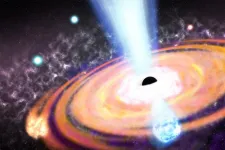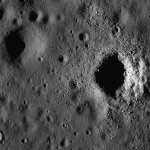(Press-News.org)
Black holes not only existed at the dawn of time, they birthed new stars and supercharged galaxy formation, a new analysis of James Webb Space Telescope data suggests.
The insights upend theories of how black holes shape the cosmos, challenging classical understanding that they formed after the first stars and galaxies emerged. Instead, black holes might have dramatically accelerated the birth of new stars during the first 50 million years of the universe, a fleeting period within its 13.8 billion—year history.
"We know these monster black holes exist at the center of galaxies near our Milky Way, but the big surprise now is that they were present at the beginning of the universe as well and were almost like building blocks or seeds for early galaxies," said lead author Joseph Silk, a professor of physics and astronomy at Johns Hopkins University and at Institut of Astrophysics, Paris, Sorbonne University. "They really boosted everything, like gigantic amplifiers of star formation, which is a whole turnaround of what we thought possible before—so much so that this could completely shake up our understanding of how galaxies form."
The work is newly published in the Astrophysical Journal Letters.
Distant galaxies from the very early universe, observed through the Webb telescope, appear much brighter than scientists predicted and reveal unusually high numbers of young stars and supermassive black holes, Silk said.
Conventional wisdom holds that black holes formed after the collapse of supermassive stars and that galaxies formed after the first stars lit up the dark early universe. But the analysis by Silk's team suggests that black holes and galaxies coexisted and influenced each other's fate during the first 100 million years. If the entire history of the universe were a 12-month calendar, those years would be like the first days of January, Silk said.
"We're arguing that black hole outflows crushed gas clouds, turning them into stars and greatly accelerating the rate of star formation," Silk said. "Otherwise, it's very hard to understand where these bright galaxies came from because they're typically smaller in the early universe. Why on earth should they be making stars so rapidly?"
Black holes are regions in space where gravity is so strong that nothing can escape their pull, not even light. Because of this force, they generate powerful magnetic fields that make violent storms, ejecting turbulent plasma and ultimately acting like enormous particle accelerators, Silk said. This process, he said, is likely why Webb's detectors have spotted more of these black holes and bright galaxies than scientists anticipated.
"We can't quite see these violent winds or jets far, far away, but we know they must be present because we see many black holes early on in the universe," Silk explained. "These enormous winds coming from the black holes crush nearby gas clouds and turn them into stars. That's the missing link that explains why these first galaxies are so much brighter than we expected."
Silk's team predicts the young universe had two phases. During the first phase, high-speed outflows from black holes accelerated star formation, and then, in a second phase, the outflows slowed down. A few hundred million years after the big bang, gas clouds collapsed because of supermassive black hole magnetic storms, and new stars were born at a rate far exceeding that observed billions of years later in normal galaxies, Silk said. The creation of stars slowed down because these powerful outflows transitioned into a state of energy conservation, he said, reducing the gas available to form stars in galaxies.
"We thought that in the beginning, galaxies formed when a giant gas cloud collapsed," Silk explained. "The big surprise is that there was a seed in the middle of that cloud—a big black hole—and that helped rapidly turn the inner part of that cloud into stars at a rate much greater than we ever expected. And so the first galaxies are incredibly bright."
The team expects future Webb telescope observations, with more precise counts of stars and supermassive black holes in the early universe, will help confirm their calculations. Silk expects these observations will also help scientists piece together more clues about the evolution of the universe.
"The big question is, what were our beginnings? The sun is one star in 100 billion in the Milky Way galaxy, and there's a massive black hole sitting in the middle, too. What's the connection between the two?" he said. "Within a year we'll have so much better data, and a lot of our questions will begin to get answers."
Authors include Colin Norman and Rosemary F. G. Wyse of Johns Hopkins; Mitchell C. Begelman of University of Colorado and National Institute of Standards and Technology; and Adi Nusser of the Israel Institute of Technology.
The team is supported by the Israel Science Foundation and the Asher Space Research Institute, as well as Eric and Wendy Schmidt by recommendation of the Schmidt Futures program.
END
Xuan Wang, Assistant Professor, Electrical and Computer Engineering, is designing a framework for Multi-Autonomous Multi-Human (MAMH) systems.
The operation of many real-world systems involves the co-existence of human and autonomous agents. Inadequate coordination among these agents can lead to significant performance degradation or safety risks.
In this project, Wang aims to develop a novel framework for Multi-Autonomous Multi-Human coordination, which could enhance algorithmic scalability and ...
CAMBRIDGE, MA -- When diagnosing skin diseases based solely on images of a patient’s skin, doctors do not perform as well when the patient has darker skin, according to a new study from MIT researchers.
The study, which included more than 1,000 dermatologists and general practitioners, found that dermatologists accurately characterized about 38 percent of the images they saw, but only 34 percent of those that showed darker skin. General practitioners, who were less accurate overall, showed a similar decrease in accuracy ...
The Vilcek Foundation announces the recipients of the 2024 Vilcek Foundation Prizes in Biomedical Science. Awarded annually since 2006, the prizes recognize outstanding immigrant scientists at the forefront of their fields, and celebrate the importance of immigrant contributions to scientific research and discovery in the United States. In 2024, the foundation awards $250,000 in prizes to Luciano Marraffini (b. Argentina), Gerta Hoxhaj (b. Albania), Tomasz Nowakowski (b. Poland) and Takanori Takebe (b. Japan).
“With the 2024 Vilcek Foundation Prizes in Biomedical Science, we honor scientists who have ...
No increased risks for babies, and for some serious neonatal complications lower risks. This is the result of the largest study to date on the safety of newborn babies whose mothers were vaccinated against COVID-19 during pregnancy. The study is a collaboration between Swedish and Norwegian researchers and is published in the journal JAMA.
COVID-19 vaccination in pregnancy was not associated with any increased risks in newborn infants. On the contrary, the study of nearly 200,000 newborns in Sweden and Norway showed that babies born by women who chose to be vaccinated ...
About The Study: In this population-based study from Sweden and Norway that included 94,000 infants exposed to COVID-19 vaccination during pregnancy and 102,000 control infants born between June 2021 and January 2023, vaccination of pregnant individuals with mRNA COVID-19 vaccines was not associated with increased risks of neonatal adverse events in their infants.
Authors: Mikael Norman, M.D., Ph.D., of the Karolinska Institutet in Stockholm, is the corresponding author.
To access the embargoed study: Visit our For The Media website at this link https://media.jamanetwork.com/
(doi:10.1001/jama.2023.26945)
Editor’s Note: Please ...
About The Study: The bivalent COVID-19 vaccines protected children and adolescents against SARS-CoV-2 infection and symptomatic COVID-19 in this study including 2,959 participants ages 5 to 17 years. These data demonstrate the benefit of COVID-19 vaccine in children and adolescents. All eligible children and adolescents should remain up to date with recommended COVID-19 vaccinations.
Authors: Leora R. Feldstein, Ph.D., of the Centers for Disease Control and Prevention in Atlanta, is the corresponding author.
To access the embargoed study: Visit our For The Media website ...
Italian scientists from Università Cattolica at Rome discovered an important genetic mechanism that pancreatic cancer cells employ to evade therapies, paving the way to new drugs for a killer disease. The tumor evades treatments by implementing a 'favorable genetic reshuffling,' strategically playing its best cards to thwart cures. This finding is the result of a study published today in the journal Cell Reports Medicine, coordinated by Claudio Sette, Professor of Human Anatomy at the Catholic University, and Director of the "Organoids Facility" at the Policlinico Universitario A. Gemelli ...
About The Study: Gun violence exposure among Black adults in the U.S. was significantly associated with lifetime suicidal ideation and behavior in this study that included 3,015 Black adults. Public health efforts to substantially reduce interpersonal gun violence may yield additional benefits by decreasing suicide among Black individuals in the U.S.
Authors: Daniel C. Semenza, Ph.D., of Rutgers University in Camden, New Jersey, is the corresponding author.
To access the embargoed study: Visit our For The Media website at this link https://media.jamanetwork.com/
(doi:10.1001/jamanetworkopen.2023.54953)
Editor’s ...
About The Study: Sustained smoking cessation was associated with a significantly reduced risk of cancer after 10 years since quitting in this study of 2.9 million Korean adults. Quitting at any age helped reduce the cancer risk, and especially for lung cancer, early cessation before middle age exhibited a substantial risk reduction.
Authors: Jin-Kyoung Oh, Ph.D., of the National Cancer Center Graduate School of Cancer Science and Policy in Goyang, Republic of Korea, is the corresponding author.
To access the embargoed study: Visit our For The Media website at ...
WASHINGTON, Feb. 6, 2024 – Earth’s moon achieved its Swiss cheese appearance from celestial objects crashing into its surface, forming impact craters. But craters weren’t all that was left behind; the intense pressure and temperature of such a collision also impacts the rocks and dust covering the lunar surface, known as regolith, altering its mineral composition and structure. Analyzing the resulting minerals provides modern researchers clues to the moon’s past.
China’s Chang’e-5, the first lunar sample ...




